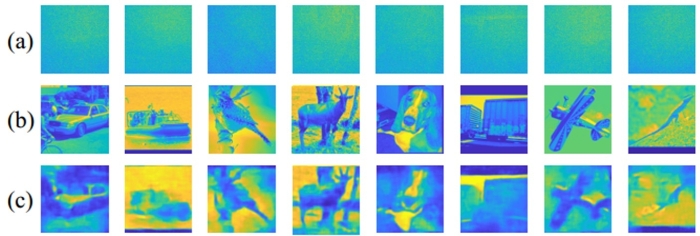Chinese researchers have demonstrated an end-to-end deep learning-based incoherent imaging method through optically thick and dynamic scattering media under a condition of strong interference noise.
This research was led by SITU Guohai from the Shanghai Institute of Optics and Fine Mechanics (SIOM) of the Chinese Academy of Sciences (CAS). Results were published in Photonics Research on 21 April 2021.
When the light propagates in turbid media, multiple scattering will occur, which has a bad effect on the image formation. How to realize imaging through strong nonstatic scattering media is one of the difficult problems in optics. Most of the existing methods rely on the certainty of the scattering process and the coherence of scattered light to extract the object information. However, the scattering process of light in dynamic turbid media is no longer deterministic, and the coherence of the scattered light will completely degenerate with the increase of the optical thickness of the medium. Imaging in such an extreme environment is a huge challenge.
This team demonstrated imaging through a 33.6cm thick glass jar filled with fat emulsion suspension (as is shown in the left of Fig. 1). For quantitative evaluation, they first used a 532nm laser as the illumination source to measure the relationship between the optical thickness and the decorrelation time of the turbid suspensions with different concentrations and determined that when the optical thickness was 16, the decorrelation time was less than 0.1 ms.
During the imaging experiments, they used an LED with a central wavelength of 532 nm as the light source, as shown in the left of Fig. 1. After scattered by the intralipid suspensions, the signal-carrying light becomes highly diffusive and is received by the camera on the other side. They also introduce a high-power ambient light to simulate interference noise encountered in many practical applications, which makes the signal-to-interference ratio as low as -17dB. In this severe condition, the object information can no longer be directly distinguished from the scattered image detected by the camera.
Their proposed method based on deep learning can directly reconstruct high-quality target images from single-frame scattered patterns. Experimentally, the final results of non-digital objects (as is shown in the right of Fig. 1) and natural scenes (Fig. 2) have successfully proved the generalization and effectiveness of this technique. It can be expected that this method has great potential in a wide scope of scattering environments.
This work was supported by Chinesisch-Deutsche Zentrum für Wissenschaftsforderung; National Natural Science Foundation of China; Chinese Academy of Sciences Key Project.

Fig. 1 The experimental setup (left) and the results of non-digital object reconstruction with the neural network trained by using digits (right). (Image by SIOM)

Fig. 2 Experimental results with natural scene object. (Image by SIOM)
Article website:
https://doi.org/10.1364/PRJ.416246
Contact:
WU Xiufeng
General Administrative Office
Shanghai Institute of Optics and Fine Mechanics, CAS
Email: xfwu@siom.ac.cn
Web: http://english.siom.cas.cn/